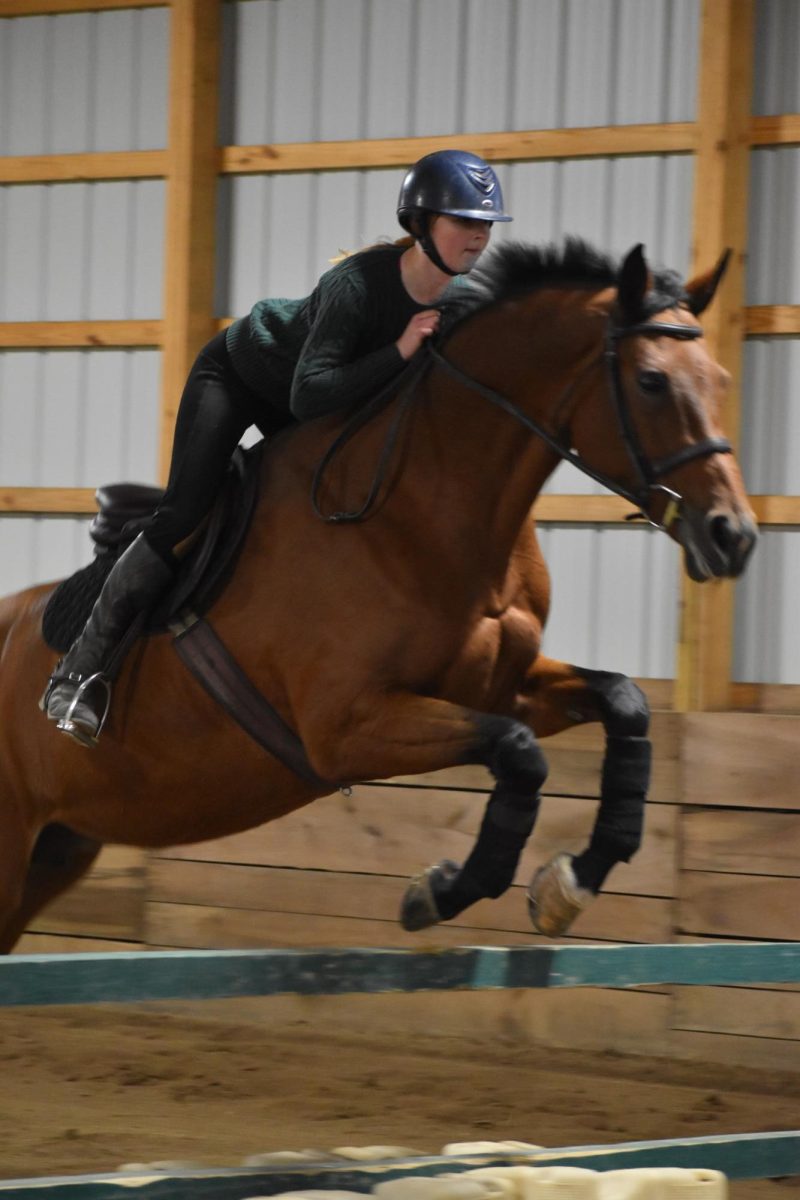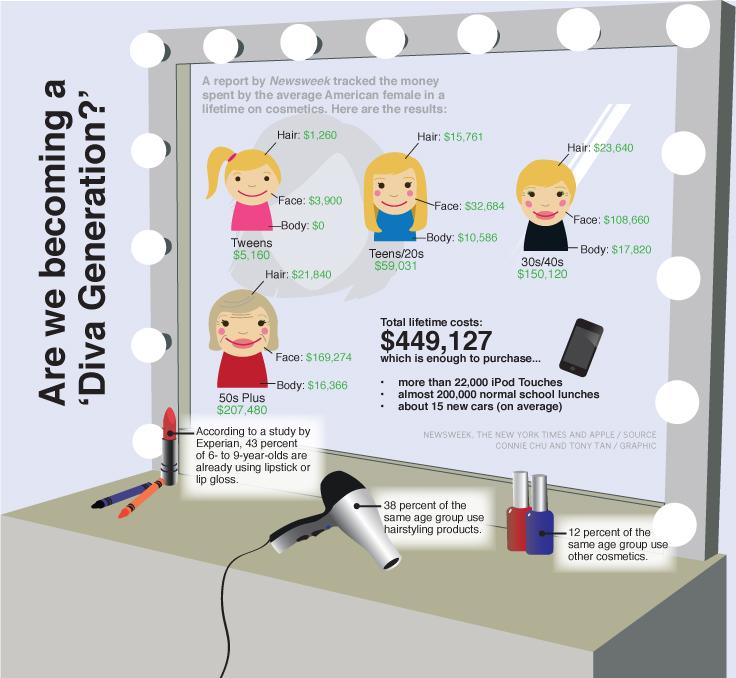“Look this way, Camera 3 is this way,” Megan Knauer, National American Miss Indiana Teen 2011 and senior, says as she narrates a beauty pageant catwalk. “Turn around this way, don’t fall. Suck in.” She takes a deep breath, imitating what contestants might do if they want to appear thinner.
Although the Teen USA beauty pageant grades on personality and poise, a large part of the critique is also based upon appearance, which Knauer, who will compete in the National American Miss Teen 2011 competition over Thanksgiving Break, said can take hours for pageant girls to prepare for.

“Hair and makeup takes one hour if you’re fast,” Knauer said. “They clear off your face completely with no makeup, and then they airbrush everything on.”
This beauty procedure reflects a typical method that cosmetics companies might use on their models to advertise their products. However, this depiction of a “perfect face” might be having quite an impact on America’s youth, specifically the younger teenage girls.
According to the NPD Group, a market-research company, in 2005 girls began using beauty products at the age of 17. A similar survey conducted in 2009 showed that the average age had decreased to 13. Today, 43 percent of 6- to 9-year-olds already use lip gloss, while 38 percent use hairstyling products, according to the market-research firm Experian. Kelly Lohrman, an esthetician who does waxes, facials and makeup at Carmel’s Salon01, said she has seen an increase in the number of girls “as young as eighth grade and up” who come in to get various cosmetic procedures done.
“I am starting to see more younger girls trying to be preventative of their skin care, so rather than having a lot of breakouts, they are coming in and having facials done,” she said, adding that those procedures have a substantial price. “It’s $45 for the teen facial,” she said. Lohrman said she believes it is the social setting that influences these girls to try methods that may have seemed unorthodox in past decades.
“When I grew up, none
of my friends got waxed until we were all probably in college,” Lohrman said. “We never had our brows waxed, we never had our legs waxed, and I’m starting to see that more with younger girls. I think the big thing is having the social network so available, like Facebook, like Myspace, because pictures are everywhere now. Your faces can be plastered all over the place now, and that’s probably one of the biggest things, because girls always want to look their best because society is telling them that they have to, and that’s not necessarily true.”

Knauer also said she believes technology plays a large role in influencing younger girls “especially in middle school” to try more and more cosmetics.
“I feel like, especially with technology and imaging and stuff, the more technology we keep getting, the more we’re trying to be perfect,” Knauer said. “Because we have this technology to make us look perfect, the more it’s affecting how early these kids are like ‘Oh my gosh, makeup’ at like 4 years old.”
Adolescents are especially vulnerable to this strong media impact of what is attractive and what is not because of their age, an age in which many people struggle to define themselves, according to Maggie Rossman, a graduate student who teaches a class on advertising and consumer culture at Indiana University.
However, although it may seem like the age for cosmetic popularity may be getting lower and lower, Rossman said young people may be more critical than they seem.
“In some of my research, I have noticed that many tweens and teens are more aware of the negative impact of some of these images,” Rossman said. “That is, they both participate in the culture, but are also able to critique it. With the proper awareness and discourse, these ads can lose some of their effect. The key is teaching young women that you don’t have to be like an ideal.”
“I know (people have) edited (the photographs),” Knauer said about pictures of previous pageant winners. “In the morning (at beauty pageants), we have roommates and we see each other without makeup, and then they put on their makeup. You don’t even recognize them.”
Knauer said even though she is well aware of the grueling makeup procedure that models endure to be presentable in an advertisement, she still occasionally finds herself tempted to be like them. “Sometimes it’s hard (when you look in a magazine),” Knauer said. “You have to fight that urge to always be perfect. To see that girl’s hair and be like, ‘I want my hair like that.’ But you have to know that the reality of that is, they’re just models, and people are doing their hair and makeup. They’re not doing it themselves. It’s not realistic.”


































![British royalty are American celebrities [opinion]](https://hilite.org/wp-content/uploads/2024/03/Screenshot-2024-03-24-1.44.57-PM.png)



















![Chelsea Meng on her instagram-run bracelet shop [Biz Buzz]](https://hilite.org/wp-content/uploads/2024/04/IMG_2446-1200x838.jpg)
![Review: Quiet on Set: The Dark Side of Kids TV is the long awaited exposé of pedophilia within the children’s entertainment industry [MUSE]](https://hilite.org/wp-content/uploads/2024/04/unnamed.jpg)
![Review: “The Iron Claw” cannot get enough praise [MUSE]](https://hilite.org/wp-content/uploads/2024/04/unnamed.png)
![Review: “The Bear” sets an unbelievably high bar for future comedy shows [MUSE]](https://hilite.org/wp-content/uploads/2024/03/unnamed.png)
![Review: “Mysterious Lotus Casebook” is an amazing historical Chinese drama [MUSE]](https://hilite.org/wp-content/uploads/2024/03/0.webp)
![Review in Print: Maripaz Villar brings a delightfully unique style to the world of WEBTOON [MUSE]](https://hilite.org/wp-content/uploads/2023/12/maripazcover-1200x960.jpg)
![Review: “The Sword of Kaigen” is a masterpiece [MUSE]](https://hilite.org/wp-content/uploads/2023/11/Screenshot-2023-11-26-201051.png)
![Review: Gateron Oil Kings, great linear switches, okay price [MUSE]](https://hilite.org/wp-content/uploads/2023/11/Screenshot-2023-11-26-200553.png)
![Review: “A Haunting in Venice” is a significant improvement from other Agatha Christie adaptations [MUSE]](https://hilite.org/wp-content/uploads/2023/11/e7ee2938a6d422669771bce6d8088521.jpg)
![Review: A Thanksgiving story from elementary school, still just as interesting [MUSE]](https://hilite.org/wp-content/uploads/2023/11/Screenshot-2023-11-26-195514-987x1200.png)
![Review: When I Fly Towards You, cute, uplifting youth drama [MUSE]](https://hilite.org/wp-content/uploads/2023/09/When-I-Fly-Towards-You-Chinese-drama.png)
![Postcards from Muse: Hawaii Travel Diary [MUSE]](https://hilite.org/wp-content/uploads/2023/09/My-project-1-1200x1200.jpg)
![Review: Ladybug & Cat Noir: The Movie, departure from original show [MUSE]](https://hilite.org/wp-content/uploads/2023/09/Ladybug__Cat_Noir_-_The_Movie_poster.jpg)
![Review in Print: Hidden Love is the cute, uplifting drama everyone needs [MUSE]](https://hilite.org/wp-content/uploads/2023/09/hiddenlovecover-e1693597208225-1030x1200.png)
![Review in Print: Heartstopper is the heartwarming queer romance we all need [MUSE]](https://hilite.org/wp-content/uploads/2023/08/museheartstoppercover-1200x654.png)






















![Review: Ladybug & Cat Noir: The Movie, departure from original show [MUSE]](https://hilite.org/wp-content/uploads/2023/09/Ladybug__Cat_Noir_-_The_Movie_poster-221x300.jpg)

![Review: Next in Fashion season two survives changes, becomes a valuable pop culture artifact [MUSE]](https://hilite.org/wp-content/uploads/2023/03/Screen-Shot-2023-03-09-at-11.05.05-AM-300x214.png)
![Review: Is The Stormlight Archive worth it? [MUSE]](https://hilite.org/wp-content/uploads/2023/10/unnamed-1-184x300.png)


